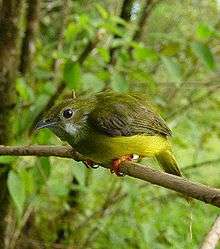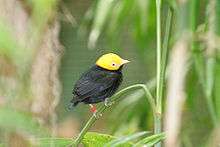Manakin
| Manakins | |
|---|---|
 | |
| Juvenile white-collared manakin | |
| Scientific classification | |
| Kingdom: | Animalia |
| Phylum: | Chordata |
| Class: | Aves |
| Order: | Passeriformes |
| Suborder: | Tyranni |
| Family: | Pipridae Rafinesque, 1815 |
| Species | |
|
Many, see text | |
_area.svg.png) | |
| Manakin range | |
The manakins are a clade (Pipridae) of unique small suboscine passerine birds. The group contains some 60 species distributed through the American tropics. The name is from Middle Dutch mannekijn "little man" (also the source of the different bird name mannikin).[1]
Description
They range in size from 7 to 15 cm (3 to 6 in) and in weight from 8 to 30 g (0.28 to 1.06 oz). The genus Tyranneutes comprise the smallest manakins, the genus Antilophia are believed to be the largest (since the Schiffornis genus are no longer considered manakins). They are compact stubby birds with short tails, broad and rounded wings, and big heads. The bill is short and has a wide gap. Females and first-year males have dull green plumage; most species are sexually dichromatic in their plumage,[2] the males being mostly black with striking colours in patches,[3] and in some species having long, decorative tail or crown feathers or erectile throat feathers. In some species, males from two to four years old have a distinctive subadult plumage.[2]
The syrinx or "voicebox" is distinctive in manakins, setting them apart from the related families Cotingidae and Tyrannidae. Furthermore, it is so acutely variable within the group that genera and even species can be identified by the syrinx alone, unlike birds of most oscine families. The sounds made are whistles, trills, and buzzes.[2]
Distribution and habitat
Manakins occur from southern Mexico to northern Argentina, Paraguay, and southern Brazil, and on Trinidad and Tobago as well. They are highly arboreal and are almost exclusively forest and woodland birds. Most species live in humid tropical lowlands, with a few in dry forests, river forests,[2] and the subtropical Andes.[4] Some highland species have altitudinal migrations.
Behaviour and ecology
Feeding
Manakins feed in the understorey on small fruit (but often remarkably large for the size of the bird[4]) including berries, and to a lesser degree, insects. Since they take fruit in flight as other species "hawk" for insects, they are believed to have evolved from insect-eating birds. Females have big territories from which they do not necessarily exclude other birds of their species, instead feeding somewhat socially. Males spend much of their time together at courtship sites. Manakins sometimes join mixed feeding flocks.[2]
Reproduction
Many manakin species have spectacular lekking courtship rituals, which are especially elaborate in the genera Pipra and Chiroxiphia. The members of the genera Machaeropterus and Manacus have heavily modified wing feathers, which they use to make buzzing and snapping sounds. Building of the nest (an open cup, generally low in vegetation), incubation for 18 to 21 days, and care of the young for 13 to 15 days are undertaken by the female alone, since most manakins do not form stable pairs. (The helmeted manakin does form pairs, but the male's contribution is limited to defending the territory.) The normal clutch is two eggs, which are buff or dull white, marked with brown.[2]
Lekking polygyny seems to have been a characteristic of the family's original ancestor, and the associated sexual selection led to an adaptive radiation in which relationships can be traced by similarities in displays. An evolutionary explanation connecting lekking to fruit-eating has been proposed.[2]
Species list
The members of the genus Schiffornis were previously placed in this family, but are now placed in Tityridae.[5]
Family Pipridae
- Genus: Dixiphia
- White-crowned manakin, Dixiphia pipra
- Genus: Pipra
- Crimson-hooded manakin, Pipra aureola (also known as orange-headed manakin)
- Band-tailed manakin, Pipra fasciicauda
- Wire-tailed manakin, Pipra filicauda
- Genus: Ceratopipra
- Golden-headed manakin, Ceratopipra erythrocephala
- Red-capped manakin, Ceratopipra mentalis
- Red-headed manakin, Ceratopipra rubrocapilla
- Round-tailed manakin, Ceratopipra chloromeros
- Scarlet-horned manakin, Ceratopipra cornuta
- Genus: Lepidothrix
- Blue-crowned manakin, Lepidothrix coronata
- Blue-rumped manakin, Lepidothrix isidorei
- Cerulean-capped manakin, Lepidothrix coeruleocapilla
- Snow-capped manakin, Lepidothrix nattereri
- Golden-crowned manakin, Lepidothrix vilasboasi
- Opal-crowned manakin, Lepidothrix iris
- Orange-bellied manakin, Lepidothrix suavissima
- White-fronted manakin, Lepidothrix serena
- Genus: Antilophia
- Helmeted manakin, Antilophia galeata
- Araripe manakin, Antilophia bokermanni
- Genus: Chiroxiphia
- Long-tailed manakin, Chiroxiphia linearis
- Lance-tailed manakin, Chiroxiphia lanceolata
- Blue-backed manakin, Chiroxiphia pareola
- Yungas manakin, Chiroxiphia boliviana
- Blue manakin, Chiroxiphia caudata
- Genus: Ilicura
- Pin-tailed manakin, Ilicura militaris
- Genus: Masius
- Golden-winged manakin, Masius chrysopterus
- Genus: Corapipo
- White-bibbed manakin, Corapipo leucorrhoa
- White-ruffed manakin, Corapipo altera
- White-throated manakin, Corapipo gutturalis
- Genus: Manacus
- White-collared manakin, Manacus candei
- Orange-collared manakin, Manacus aurantiacus
- Golden-collared manakin, Manacus vitellinus
- White-bearded manakin, Manacus manacus
- Genus: Machaeropterus
- Fiery-capped manakin, Machaeropterus pyrocephalus
- Striped manakin, Machaeropterus regulus
- Eastern striped manakin, Machaeropterus (r.) regulus
- Western striped manakin, Machaeropterus (regulus) striolatus
- Club-winged manakin, Machaeropterus deliciosus
- Genus: Xenopipo
- Black manakin, Xenopipo atronitens
- Olive manakin, Xenopipo uniformis
- Genus: Cryptopipo
- Green manakin, Cryptopipo holochlora
- Lita manakin, Cryptopipo (holochlora) litae
- Green manakin, Cryptopipo holochlora
- Genus: Chloropipo
- Yellow-headed manakin, Chloropipo flavicapilla
- Jet manakin, Chloropipo unicolor
- Genus: Heterocercus
- Flame-crested manakin, Heterocercus linteatus
- Orange-crested manakin, Heterocercus aurantiivertex
- Yellow-crested manakin, Heterocercus flavivertex
- Genus: Neopelma
- Saffron-crested tyrant-manakin, Neopelma chrysocephalum
- Sulphur-bellied tyrant-manakin, Neopelma sulphureiventer
- Pale-bellied tyrant-manakin, Neopelma pallescens
- Wied's tyrant-manakin, Neopelma aurifrons
- Serra do Mar tyrant-manakin, Neopelma chrysolophum
- Genus: Tyranneutes
- Dwarf tyrant-manakin, Tyranneutes stolzmanni
- Tiny tyrant-manakin, Tyranneutes virescens
- Genus: Piprites - placement in present family questionable.[5]
- Black-capped piprites, Piprites pileatus
- Grey-headed piprites, Piprites griseiceps
- Wing-barred piprites, Piprites chloris
 Male white-bearded manakin at its lek
Male white-bearded manakin at its lek_male_from_rear.jpg) Helmeted manakin (Antilophia galeata)
Helmeted manakin (Antilophia galeata)_01.jpg) Blue-backed manakin (Chiroxiphia pareola)
Blue-backed manakin (Chiroxiphia pareola) White-crowned manakin (Dixiphia pipra)
White-crowned manakin (Dixiphia pipra) Golden-headed manakin (Pipra erythrocephala)
Golden-headed manakin (Pipra erythrocephala) Golden-winged manakin (Masius chrysopterus)
Golden-winged manakin (Masius chrysopterus)
References
- ↑ New Oxford American Dictionary (2nd ed., 2005), p. 1032.
- 1 2 3 4 5 6 7 Prum, Richard O.; Snow, David W. (2003). "Manakins". In Perrins, Christopher. The Firefly Encyclopedia of Birds. Firefly Books. pp. 434–437. ISBN 1-55297-777-3.
- ↑ Lanyon, Scott N. (1991). Forshaw, Joseph, ed. Encyclopaedia of Animals: Birds. London: Merehurst Press. pp. 167–168. ISBN 1-85391-186-0.
- 1 2 Snow, D. W. (2004). Family Pipridae (Manakins). Pp. 110-169 in: del Hoyo, J., Elliott, A., & Christie, D. A. eds (2004). Handbook of the Birds of the World. Vol. 9. Cotingas to Pipits and Wagtails. Lynx Edicions, Barcelona. ISBN 84-87334-69-5
- 1 2 Remsen, J. V., Jr., C. D. Cadena, A. Jaramillo, M. Nores, J. F. Pacheco, M. B. Robbins, T. S. Schulenberg, F. G. Stiles, D. F. Stotz, & K. J. Zimmer. 2007. A classification of the bird species of South America. American Ornithologists' Union. Accessed 12 December 2007.
External links
| Wikimedia Commons has media related to Pipridae. |
- "Jungle Dancers", Nature article about manakin behaviour, from the PBS website
- "High-speed videos of two manakin clades (Pipridae: Aves)", from the Journal of Experimental Biology website
- Videos of Machaeropterus deliciosus making a "tick-tick-ting" sound through wing motion, from the Science website
- Manakin videos, photos and sounds on the Internet Bird Collection
- "Manakins and the Plant Family Melastomataceae", from the Ecology Online Sweden website